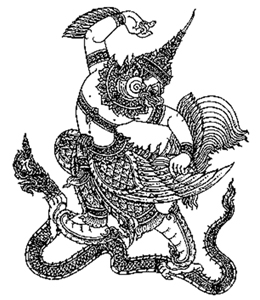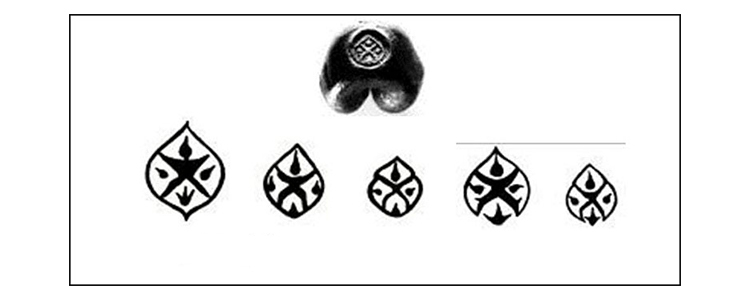The concept of Garuda in Thai society
Thailand has inherited the Hindu idea of god from Cambodia. It is believed that a king is an avatar of Narayana, descending from heaven to rule lands and patronize men on earth. Garuda, usually the mount of Narayana, has therefore been the esteemed symbol of the King until today.
It is a mythical creature of the Himmapan forest
Garuda is the king of birds with supernatural power and strength. It is a mythical creature of the Himmapan forest, half-man and half-bird. Descriptions of his castle vary from legend to legend. The Buddhist Cosmology Dhonburi Version defines that Garuda was seated at the second foothill paradise of Mount Meru. Some textbooks say he lived at the Peak of Guttha Sanmali Mountain on Malay Peninsula. The word "Sanmali” is pronounced in Pali "Simpli”, meaning Garuda’s paradise.
Legends describe the origin of Garuda in different details. To summarize, among many wives of Kasyapa, there were two sisters named Vinata and Kadru. The former was the ancestral mother of Garuda; the latter was of Naga, a great snake. Both were granted their wishes from the husband. Kadru wished for a thousand of Nagas as her sons, which would live underworld in the ocean depth. Vinata wished for only two sons. The sisters both laid eggs, but the hatching of Vinata’s two eggs took a long time. Waiting for 500 years, she decided to break open one egg, which came out as a boy named Aruna. Only his upper half of the body was formed. Having learned that the mother was the reason of his deformity, he grew furious and cursed her that she became a slave of her own sister for 500 years. He then flew away up in the sky to be the charioteer of the sun, seen as red spectacles at sunrise.
The curse of Aruna finally came true when Vinata and Kadru made a bet on the colour of the Sun’s horse. Vinata bet for white, while Kadru for black. Kadru laid a plot that her Naga sons transformed into black hairs and covered the horse (some textbooks say that the Nagas poisoned the horse). Vinata, therefore, lost the bet and became enslaved to her sister for 500 years.
Garuda hatched out of the second egg. At birth, his body was so large that it could reach the sky. His eyes twinkled like a flash of lighting. The body glowed and shined. Garuda flew to seek and found his mother. Having told about Kadru’s trick, he was angry at her and Nagas. Garuda offered to trade anything for Vinata’s freedom and Kadru asked for the immortal elixir, Amarita. He immediately rushed to find it.
After Garuda has obtained the Amarita, Indra appeared to stop him. Garuda was yet more powerful and broke Indra’s weapon Vajra. Narayana had to descend from heaven to assist Indra but could not conquer the King of birds. They finally made a compromise. Garuda expressed his desires, "May I always stay higher than You? And without the Amarita, may I be immortal and never fall down?” Granted the wishes from Narayana, Garuda said, "I may bestow You one wish.” Narayana replied, "Be my mount. You may stay at my flag pole, so that you stand higher than me.” This event was the origin of the Narayana on Garuda mudra. Asked to return the Amarita, Garuda, however, needed to keep the oath given to Kadru and Nagas, in order to free his mother. He begged Indra to take it back later from them.
The inscription of Garuda Battling Naga Serpent on a golden Chest in the period of King Rama II
The belief in Garuda has existed in Thai society since ancient times, as seen in fine arts, architecture, paintings, sculptures, literature and classical dances. The concept of Garuda during Sukhothai Era was influenced from Buddhist mythology. The sculptures of Garuda, therefore, appear in many sacred places. In Ayutthaya Dynasty, the Hindu belief of god played a great role. The idea that a king is an avatar of Ramayana made Garuda important. Believed to be Ramayana’s mount, Garuda has since then been the symbol of royal authority and the grand decoration for the King’s assets and belongings. The good examples are the Garuda seal on official verbal notes and royal seals. Garuda is as well used as the emblem on royal assets and royal decorations, which are awarded to royalties, nobles and superior officials. For instance, a golden chest is inscribed Garuda battling naga serpent. Moreover, Garuda is a main embellishment on royal cars, planes and barges – the Royal Barge Narai Song Suban, the Royal Barge Krut Hern Hed How and the royal barge Krut Tret Traichak. Ultimately, Garuda appears as an outstanding emblem on the royal standard hoisted at the King’s palace of residence.
Garuda as a symbol of Thai currency
Symbols on Thai currency regularly present state authority of nation, religion and the King. Garuda, as related to the royal institution, has for all time been one of the symbols. The earliest evidence is Pod Duang money (bullet coins) of Ayutthaya period during the reign of King Narai. It has two inscriptions: the Chakra wheel and Garuda. The former was the national emblem and the latter the royal emblem. Each reign has its own design of royal emblem.
The Garuda inscription on the Pod Duang in Ayudhaya Era (King Narai)
The Pod Duang in later reigns of Ayuthaya Dynasty had not been found with any Garuda inscription. During the early period of Rattanakosin, King Rama II ordered Garuda be the royal emblem on the Pod Duang, because the King’s birth name was Chim, short form of Chimplee – Thai pronunciation for Garuda’s paradise.
The Garuda inscription on the Ratanakosin Pod Duang (King Rama II)
In the following reign, King Rama III ordered the Pod Duang with left-facing Garuda to be made as a commemoration for the funeral ceremony of his father King Rama II in 1825.
The left-facing Garuda Variation on the Pod Duang (King Rama III)
During the rule of King Rama IV, due to the European Imperialism, Thai commerce grew largely. The hand-making of Pod Duang could not meet the increasing demand of trade. King Rama VI, therefore, imported a coining machine from England to produce modern flat coins. The first Royal Mint, given the name Sidhikarn, was established inside the Grand Palace. The Pod Duang in Thai trade was gradually replaced by the flat coins and it was eventually withdrawn from circulation during the reign of King Rama V.
The great change of Thai monetary pattern from the Pod Duang to flat coins and the first use of "notes”- the beginning of banknotes, was the international step of Thai currency. Besides the change, Garuda continues its important role in modern Thai currency, both coins and banknotes. The first flat coin with Garuda imprint appeared in the reign of King Rama V, when Prince Narisaranuvatiwongse made a design of 1 Baht coin. However, it did not receive the royal permission of use.
Ramayana on Garuda was inscribed on a Thai coin in the reign of King Rama V.
Garuda is present on Thai money once again in the reign of King Rama VIII. Two models of coins were produced in 1954. On the obverse side, the first one had the King’s portrait at a very young age, while the second bore the King’s appearance at prospering age. Both were inscribed Garuda with broad wings on the reverse side. Each model was made of 4 values: 50 Satang, 25 Satang, 10 Satang and 5 Satang.
Garuda inscription on the coins in the reign of King Rama VII (at young age). (Left image)
Garuda inscription on the coins in the reign of King Rama VIII (at prospering age). (Central image)
Garuda inscription on the coins in the reign of King Rama IX (Central image)
In the reign of King Rama IX, Garuda was repeatedly used as the symbol on coins. The first time was in 1972 when cupronickel 5 Baht coins were introduced. The facing side bore the King’s portrait, while on the reverse the broad-winged Garuda. They were the pioneer model which was made in a shape of nonagon or nine sided. More copies were made many times but the production year appearing on the coin remained the same. In 1974, cupronickel 1 Baht coins with the same imprint were brought out. They were reproduced one year later but the year, again, was not changed. In 1977 and 1979, cupronickel-clad copper 5 Baht coins were introduced. The main side had the inscription of the King, while on the secondary the about-face broad-winged Garuda. The coins were to replace the nine-sided model, which had encountered a forgery. In 1982, new cupronickel-clad copper 5 Baht coins were made with the broad-winged Garuda facing straight on the reverse side. Since then, no more Thai coins in circulation were seen with any imprint of Garuda.
Not only on the Pod Duang and the coins, but Garuda was as well used as a symbol on banknotes. Since 2431 during the reign of King Rama V, due to the shortage of coins, foreign commercial banks have been granted official permission to use notes for settlement in Thailand. Banknotes are commonly and shortly called "bank” in Thailand. In 2445, Thai government issued Thai notes for the first time. They were printed in England with the Thai arm code. In the rule of King Rama VI, Garuda was initially sealed on 1 Baht notes. More Garuda seals were affixed on banknotes of 5 values: 5 Baht, 10 Baht, 20 Baht, 100 Baht and 1000 Baht.
In the rule of King Rama VI, Garuda was initially sealed on 1 Baht notes. More Garuda seals were affixed on banknotes of 5 values: 5 Baht, 10 Baht, 20 Baht, 100 Baht and 1000 Baht.
During the reign of King Rama VII, notes with the king’s portrait were first issued in 2477. The King and Garuda appeared on notes of 4 values: 1 Baht, 5 Baht, 10 Baht and 20 Baht. All notes issued in the time of King Rama IX continually have both images of the King and Garuda.
All notes issued in the time of King Rama IX continually have both images of the King and Garuda.
To summarize, since ancient times until today, Garuda in the Thai belief has influenced Thai money, the medium in the commerce and trade. As the Thai royal symbol, Garuda has thus appeared in various forms of Thai currency until today.
Translated from
Natthikarn Chantayod. (2013). Garuda: a symbol on Thai currency.Retrieved June 17, 2013, from Pavilion of Regalia, Royal Decorations and Coins e-museum: http://emuseum.treasury.go.th/ (Thai language)








